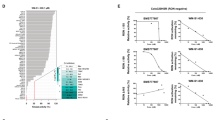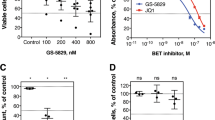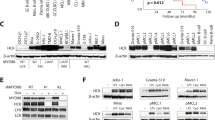Abstract
SLAMF7 is expressed mainly on multiple myeloma (MM) cells and considered an ideal target for immunotherapeutic approaches. Indeed, elotuzumab, an anti-SLAMF7 antibody, is used for the treatment of MM in combination with immunomodulatory drugs. SLAMF7 is cleaved via unknown mechanisms and detected as a soluble form (sSLAMF7) exclusively in the serum of MM patients; however, little is known about the role of sSLAMF7 in MM biology. In this study, we found that sSLAMF7 enhanced the growth of MM cells via homophilic interaction with surface SLAMF7 and subsequent activation of the SHP-2 and ERK signaling pathways. Elotuzumab suppressed sSLAMF7-induced MM cell growth both in vitro and in vivo. Promoter analyses identified IKZF1 (Ikaros) as a pivotal transcriptional activator of the SLAMF7 gene. Pharmacological targeting of Ikaros by lenalidomide and its analog pomalidomide downregulated SLAMF7 expression and ameliorated the response of MM cells to sSLAMF7. Elotuzumab blocked the growth-promoting function of sSLAMF7 when combined with lenalidomide in a murine xenograft model. Neutralization of sSLAMF7 is a novel antimyeloma mechanism of elotuzumab, which is enhanced by immunomodulatory drugs via downregulation of surface SLAMF7 expression on MM cells. These findings may provide important information for the optimal use of elotuzumab in MM treatment.
This is a preview of subscription content, access via your institution
Access options
Subscribe to this journal
Receive 12 print issues and online access
$259.00 per year
only $21.58 per issue
Buy this article
- Purchase on Springer Link
- Instant access to full article PDF
Prices may be subject to local taxes which are calculated during checkout







Similar content being viewed by others
References
Siegel RL, Miller KD, Jemal A. Cancer statistics, 2019. CA Cancer J Clin. 2019;69:7–34.
Ozaki S, Handa H, Saitoh T, Murakami H, Itagaki M, Asaoku H, et al. Trends of survival in patients with multiple myeloma in Japan: a multicenter retrospective collaborative study of the Japanese Society of Myeloma. Blood Cancer J. 2015;5:e349.
Kumar SK, Dispenzieri A, Lacy MQ, Gerz MA, Buadi FK, Pandey S, et al. Continued improvement in survival in multiple myeloma: changes in early mortality and outcomes in older patients. Leukemia. 2014;28:1122–8.
Kumar SK, Dimopoulos MA, Kastritis E, Terpos E, Nahi H, Goldschmidt H, et al. Natural history of relapsed myeloma, refractory to immunomodulatory drugs and proteasome inhibitors: a multicenter IMWG study. Leukemia. 2017;31:2443–8.
Touzeau C, Moreau P, Dumontet C. Monoclonal antibody therapy in multiple myeloma. Leukemia. 2017;127:1039–47.
Taniwaki M, Yoshida M, Matsumoto Y, Shimura K, Kuroda J, Kaneko H. Elotuzumab for the treatment of relapsed or refractory multiple myeloma, with special reference to its modes of action and SLAMF7 signaling. Mediterr J Hematol Infect Dis. 2018;10:e2018014.
Palumbo A, Chanan-Khan A, Weisel K, Nooka AK, Masszi T, Beksac M, et al. Daratumumab, bortezomib, and dexamethasone for multiple myeloma. N Engl J Med. 2016;375:754–66.
Dimopoulos MA, Oriol A, Nahi H, San-Miguel J, Bahlis NJ, Usmani SZ, et al. Daratumumab, lenalidomide, and dexamethasone for multiple myeloma. N Engl J Med. 2016;375:1319–31.
Suzuki K, Dimopoulos MA, Takezako N, Okamoto S, Shinagawa A, Matsumoto N, et al. Daratumumab, lenalidomide, and dexamethasone in East Asian patients with relapsed or refractory multiple myeloma: subgroup analyses of the phase 3 POLLUX study. Blood Cancer J. 2018;8:41.
Mateos M-V, Dimopoulos MA, Cavo M, Suzuki K, Jakubowiak A, Knop S, et al. Daratumumab plus bortezomib, melphalan, and prednisone for untreated myeloma. N Engl J Med. 2018;378:518–28.
Lonial S, Dimopoulos M, Palumbo A, White D, Grosicki S, Spika I, et al. Elotuzumab therapy for relapsed or refractory multiple myeloma. N Engl J Med. 2015;373:621–31.
Jakubowiak A, Offidani M, Pégourie B, De La Rubia J, Garderet L, Laribi K, et al. Randomized phase 2 study: elotuzumab plus bortezomib/dexamethasone vs bortezomib/dexamethasone for relapsed/refractory MM. Blood. 2016;127:2833–40.
Iida S, Nagai H, Kinoshita G, Miyoshi M, Robbins M, Pandya D, et al. Elotuzumab with lenalidomide and dexamethasone for Japanese patients with relapsed/refractory multiple myeloma: phase 1 study. Int J Hematol. 2017;105:326–34.
Demopoulos MA, Dytfeld D, Grosicki S, Moreau P, Takezako N, Hori M, et al. Elotuzumab plus pomalidomide and dexamethasone for multiple myeloma. N Engl J Med. 2018;379:1811–22.
Wu N, Veillette A. SLAM family receptors in normal immunity and immune pathologies. Curr Opin Immunol. 2016;38:45–51.
Hsi ED, Steinle R, Balasa B, Szmania S, Draksharapu A, Shum B, et al. CS1, a potential new therapeutic antibody target for the treatment of multiple myeloma. Clin Cancer Res. 2008;14:2775–84.
Tai Y-T, Dillon M, Song W, Leiba M, Li X-F, Burger P, et al. Anti-CS1 humanized monoclonal antibody HuLuc63 inhibits myeloma cell adhesion and induces antibody-dependent cellular cytotoxicity in the bone marrow milieu. Blood. 2008;112:1329–37.
Dong Z, Cruz-Munoz ME, Zhong MC, Chen R, Latour S, Veillette A. Essential function for SAP family adaptors in the surveillance of hematopoietic cells by natural killer cells. Nat Immunol. 2009;10:973–80.
Collins SM, Bakan CE, Swartzel GD, Hofmeister CC, Efebera YA, Kwon H, et al. Elotuzumab directly enhances NK cell cytotoxicity against myeloma via CS1 ligation: evidence for augmented NK cell function complementing ADCC. Cancer Immunol Immunother. 2013;62:1841–9.
Guo H, Cruz-Munoz ME, Wu N, Robbins M, Veillette A. Immune cell inhibition by SLAMF7 is mediated by a mechanism requiring src kinases, CD45, and SHIP-1 that is defective in multiple myeloma cells. Mol Cell Biol. 2015;35:41–51.
Chen J, Zhong M-C, Guo H, Davidson D, Mishel S, Lu Y, et al. SLAMF7 is critical for phagocytosis of haematopoietic tumour cells via Mac-1 integrin. Nature. 2017;544:493–7.
Kurdi AT, Glavey SV, Bezman NA, Jhatakia A, Guerriero JL, Manier S, et al. Antibody-dependent cellular phagocytosis by macrophages is a novel mechanism of action of elotuzumab. Mol Cancer Ther. 2018;17:1454–63.
Postelnek J, Neely RJ, Robbins MD, Gleason CR, Peterson JE, Piccoli SP. Development and validation of electrochemiluminescence assays to measure free and total sSLAMF7 in human serum in the absence and presence of elotuzumab. AAPS J. 2016;18:989–99.
Ishibashi M, Soeda S, Sasaki M, Handa H, Imai Y, Tanaka N, et al. Clinical impact of serum soluble SLAMF7 in multiple myeloma. Oncotarget. 2018;9:34784–93.
Kikuchi J, Kuroda Y, Koyama D, Osada N, Izumi T, Yasui H, et al. Myeloma cells are activated in bone marrow microenvironment by the CD180/MD-1 complex which senses lipopolysaccharide. Cancer Res. 2018;78:1766–78.
Kikuchi J, Koyama D, Wada T, Izumi T, Hofgaard PO, Bogen B, et al. Phosphorylation-mediated EZH2 inactivation promotes drug resistance in multiple myeloma. J Clin Investig. 2015;125:4375–90.
Saito S, Kikuchi J, Koyama D, Sato S, Koyama H, Osada N, et al. Eradication of central nervous system leukemia of T-cell origin with a brain-permeable LSD1 inhibitor. Clin Cancer Res. 2019;25:1601–11.
Kikuchi J, Wada T, Shimizu R, Izumi T, Akutsu M, Mitunaga K, et al. Histone deacetylases are critical targets of bortezomib-induced cytotoxicity in multiple myeloma. Blood. 2010;116:406–17.
Maroun CR, Naujokas MA, Holgado-Madruga M, Wong AJ, Park M. The tyrosine phosphatase SHP-2 is required for sustained activation of extracellular signal-regulated kinase and epithelial morphogenesis downstream from the met receptor tyrosine kinase. Mol Cell Biol. 2000;20:8513–25.
Gu S, Sayad A, Chan G, Yang W, Lu Z, Virtanen C, et al. SHP2 is required for BCR-ABL1-induced hematologic neoplasia. Leukemia. 2018;32:203–13.
Mainardi S, Mulero-Sánchez A, Prahallad A, Germano G, Bosma A, Krimpenfort P, et al. SHP2 is required for growth of KRAS-mutant non-small-cell lung cancer in vivo. Nat Med. 2018;24:961–7.
Lapalombella R, Yu B, Triantafillou G, Liu Q, Butchar JP, Lozanski G, et al. Lenalidomide down-regulates the CD20 antigen and antagonizes direct and antibody-dependent cellular cytotoxicity of rituximab on primary chronic lymphocytic leukemia cells. Blood. 2008;112:5180–9.
Fedele PL, Willis SN, Liao Y, Low MS, Rautela J, Segal DH, et al. IMiDs prime myeloma cells for daratumumab-mediated cytotoxicity through loss of Ikaros and Aiolos. Blood. 2018;132:2166–78.
Kim JR, Mathew SO, Mathew PA. Blimp-1/PRDM1 regulates the transcription of human CS1 (SLAMF7) gene in NK and B cells. Immunobiology. 2016;221:31–9.
Krönke J, Udeshi ND, Narla A, Grauman P, Hurst SN, McConkey M, et al. Lenalidomide causes selective degradation of IKZF1 and IKZF3 in multiple myeloma cells. Science. 2014;343:301–5.
Lu G, Middleton RE, Sun H, Naniong M, Ott CJ, Mitsiades CS, et al. The myeloma drug lenalidomide promotes the cereblon-dependent destruction of Ikaros proteins. Science. 2014;343:305–9.
Bjorklund CC, Lu L, Kang J, Hagner PR, Havens CG, Amatangelo M, et al. Rate of CRL4CRBN substrate Ikaros and Aiolos degradation underlies differential activity of lenalidomide and pomalidomide in multiple myeloma cells by regulation of c-Myc and IRF4. Blood Cancer J. 2015;5:e354.
Zonder JA, Mohrbacher AF, Singhal S, van Rhee F, Bensinger WI, Ding H, et al. A phase 1, multicenter, open-label, dose escalation study of elotuzumab in patients with advanced multiple myeloma. Blood. 2012;120:552–9.
van Rhee F, Szmania SM, Dillon M, van Abbema AM, Li X, Stone MK, et al. Combinatorial efficacy of anti-CS1 monoclonal antibody elotuzumab (HuLuc63) and bortezomib against multiple myeloma. Mol Cancer Ther. 2009;8:2616–24.
Cartron G, Dacheux L, Salles G, Solal-Celigny P, Bardos P, Colombat P, et al. Therapeutic activity of humanized anti-CD20 monoclonal antibody and polymorphism in IgG Fc receptor FcγRIIIa gene. Blood. 2002;99:754–8.
Poulart V, Jou YM, Delmonte T, Robbins M. Fc-gamma receptor polymorphisms and progression-free survival: analysis of three clinical trials of elotuzumab in multiple myeloma. Haematologica 2016;101(Suppl 1):529–30.
Postelnek J, Sheridan J, Keller S, Pazina T, Sheng J, Poulart V, et al. Effects of elotuzumab on soluble SLAMF7 levels in multiple myeloma. Blood. 2015;126:2964.
He Y, Bouwstra R, Wiersma VR, de Jong M, Jan Lourens H, Fehrmann R, et al. Cancer cell-expressed SLAMF7 is not required for CD47-mediated phagocytosis. Nat Commun. 2019;10:533.
Furukawa Y, Kikuchi J. Molecular pathogenesis of multiple myeloma. Int J Clin Oncol. 2015;20:413–22.
Weinhold N, Ashby C, Rasche L, Chavan SS, Stein C, Stephens OW, et al. Clonal selection and double-hit events involving tumor suppressor genes underlie relapse in myeloma. Blood. 2016;128:1735–44.
Johnson DC, Lenive O, Mitchell J, Jackson G, Owen R, Drayson M, et al. Neutral tumor evolution in myeloma is associated with poor prognosis. Blood. 2017;130:1639–43.
Xie Z, Gunaratne J, Cheong LL, Liu SC, Koh TL, Huang G, et al. Plasma membrane proteomics identifies biomarkers associated with MMSET overexpression in t(4;14) multiple myeloma. Oncotarget. 2013;4:1008–18.
Acknowledgements
We are grateful to Ms Akiko Yonekura and Ms Michiko Ogawa as well as the Core Center of Research Apparatus, Jichi Medical University for technical assistance. This work was supported by the Ministry of Education, Culture, Sports, Science and Technology-supported program for the Strategic Foundation at Private Universities, the Bristol-Myers Squibb Research Grant (to YF), and a Grant-in-Aid for Scientific Research from JSPS (to JK, DK, and YF). JK and YF were funded by the Japan Leukemia Research Fund, Yasuda Memorial Cancer Foundation, Takeda Science Foundation, and Novartis Foundation Japan. JK was also funded by Mitsui Life Social Welfare Foundation and SENSHIN Medical Research Foundation. JK received the Kano Foundation Research Grant and the International Myeloma Foundation Japan’s Grant.
Author information
Authors and Affiliations
Contributions
JK, MH and HI performed experiments, analyzed data, and drafted the paper; NTS and SH measured sSLAMF7 in clinical and experimental samples, YK and DK performed experiments; TI and HY provided clinical samples and cell lines; and AS and YF designed and supervised research and finalized the paper. All authors read and approved the paper before submission.
Corresponding author
Ethics declarations
Conflict of interest
This study was funded by Bristol-Myers Squibb K.K. AS is an employee of Bristol-Myers Squibb K.K.
Additional information
Publisher’s note: Springer Nature remains neutral with regard to jurisdictional claims in published maps and institutional affiliations.
Supplementary information
Rights and permissions
About this article
Cite this article
Kikuchi, J., Hori, M., Iha, H. et al. Soluble SLAMF7 promotes the growth of myeloma cells via homophilic interaction with surface SLAMF7. Leukemia 34, 180–195 (2020). https://doi.org/10.1038/s41375-019-0525-6
Received:
Revised:
Accepted:
Published:
Issue Date:
DOI: https://doi.org/10.1038/s41375-019-0525-6
This article is cited by
-
Bispecific CS1-BCMA CAR-T cells are clinically active in relapsed or refractory multiple myeloma
Leukemia (2024)
-
Alternative splicing in multiple myeloma is associated with the non-homologous end joining pathway
Blood Cancer Journal (2023)
-
Efficacy of elotuzumab for multiple myeloma in reference to lymphocyte counts and kappa/lambda ratio or B2 microglobulin
Scientific Reports (2023)
-
Patient selection for CAR T or BiTE therapy in multiple myeloma: Which treatment for each patient?
Journal of Hematology & Oncology (2022)
-
Soluble SLAMF7 is a predictive biomarker for elotuzumab therapy
Leukemia (2020)



